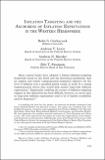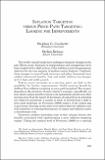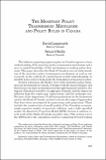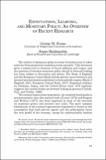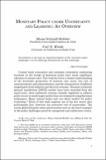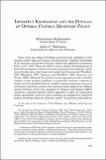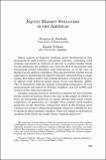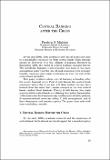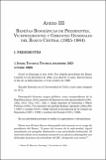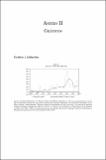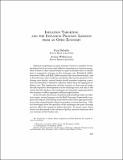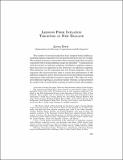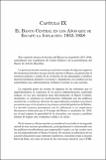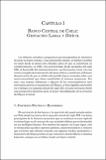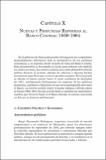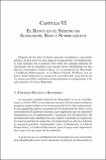Buscar
Mostrando ítems 1-20 de 88
Inflation targeting and the anchoring of inflation expectations in the Western hemisphere
Many central banks have adopted a formal inflation-targeting framework based on the belief and the theoretical predictions that an explicit and clearly communicated numerical objective for the level of inflation over a specified period would, in itself, be a strong communication device that would help ...
Inflation targeting versus price-path targeting: looking for improvements
The world’s central banks have undergone dramatic changes in the past fifteen years. Increases in independence and transparency have been coupled with a shift in focus. Price stability is now the paramount objective for the vast majority of modern central bankers. Combined, these changes in central ...
The monetary policy transmission mechanism and policy rules in Canada
The inflation targeting regime in place in Canada requires a clear understanding of the monetary policy transmission mechanism and a way to exploit knowledge of that mechanism in making policy decisions. This paper describes the Bank of Canada's current undestanding of the monetary policy transmission ...
Expectations, learning and monetary policy: an overview of recent research
The conduct of monetary policy in terms of interest rate or other rules has been extensively studied in recent research. This literature gives a central role to forecasts of future inflation and output, and the question of whether monetary policy should be forward- ooking has been subject to discussion ...
Monetary policy under uncertainty and learning: an overview
Central bank economists and academic economists conducting research on the design of monetary policy have made significant advances in recent years. This work has led to a clearer understanding of the desirable properties of interest rate rules, the role of announcements and communication, and the ...
Imperfect knowledge and the pitfalls of optimal control monetary policy
Sixty years ago, Milton Friedman questioned the usefulness of the optimal control approach because of policymakers’ imperfect knowledge of the economy and favored instead a simple rule approach to monetary policy (1947, 1948). These are still live issues, despite the development of powerful techniques ...
Equity market spillovers in the Americas
Many aspects of financial markets merit monitoring in risk management and portfolio allocation contexts, including (and perhaps especially) in contexts of interest to central banks. Much recent attention, for example, has been devoted to measuring and forecasting return volatilities and correlations, ...
Central banking after the crisis
By the mid-2000s both academics and central banks had come to a remarkable consensus on what central banks’ basic strategy should be. However with the collapse of Lehman Brothers in September 2008 the world of central banking changed forever. The worldwide financial crisis revealed that some of the ...
Banco Central de Chile 1925-1964: una historia institucional
La serie de libros 'Banca Central Análisis y Políticas Económicas' del Banco Central de Chile publica trabajos inéditos sobre banca central y sobre la economía en general con énfasis en temas y políticas relacionados con la conducción económica de los países en desarrollo. La publicación de los libros ...
New frontiers for menetary policy in Chile
Inflation targeting can be broadly defined as a framework for the conduct of MONETARY POLICY in which the central bank guides its instruments in order to hold inflation near a preannounced target or to bring back to the target. Although understanding the framework is straightfoward, its practical ...
Inflation targeting and the inflation process: lessons from an open economy
Inflation targeting in an open economy insolves a number of complexities that do not arise with inflation targeting in a clises economy. One of these is that central banks in open economies have to decide how to repond to changes in the exchange rate.
Lessons from inflation targeting in New Zealand
The number of central banks that have adopted formal inflation targeting regimes expanded over the past decade from only one to eight. The number increases even further when central banks that set policy consistent with a formal inflation target are included. Commesurate with the formal or informal ...
El Banco Central en los años que se escapó la inflación: 1953-1958
Este capítulo abarca la historia del Banco en el período 1953-1958 coincidente con el gobierno de Carlos Ibáñez y de la presidencia del Banco de Arturo Maschke. La primera sección constituye una breve reseña de algunos aspectos del momento histórico en que estaba inserto el Banco en particular el ...
Banco Central de Chile: gestión larga y difícil
Los debates estudios y propuestas que incorporaban la iniciativa de crear un banco central o una institución similar se habían sucedido en Chile desde al menos tres décadas antes de que se concretara su establecimiento en 1925. Con anterioridad desde mediados del siglo XIX el desarrollo del sistema ...
Nuevas y profundas reformas al Banco Central: 1959-1964
En el gobierno de Alessandri pueden distinguirse dos subperíodos marcadamente diferentes bajo la perspectiva de las políticas económicas y en especial desde el punto de vista del Banco Central. Esta característica se ha tomado en cuenta para ordenar este capítulo en cuatro secciones. La primera entrega ...
El Banco en el sexenio de Alessandri Ross y Subercaseaux
Después de los años de fuerte recesión económica y convulsión política el país entró en una etapa de recuperación y normalización lo cual coincidió con el período 1933-1938 del segundo gobierno de Alessandri. En lo económico este sexenio estuvo identificado con dos figuras principales: Gustavo Ross ...
The three E’s of central-bank communication with the public
Central banks used to ask, “Shall we communicate this?” Now, as a rule, they ask, “Why wouldn’t we communicate this?” This
first wave of the revolution in central-bank communication is giving rise to a second wave. The question increasingly is, “How should we communicate this in a way that engages a ...
The transformation and performance of emerging market economies across the great divide of the global financial crisis
Before the Global Financial Crisis, a drive towards greater central-bank autonomy and transparency, as part of the achievement of greater central-bank credibility that had begun in the advanced economies (AE), spread to the emerging market economies (EME). This process was greatly enhanced by the ...

